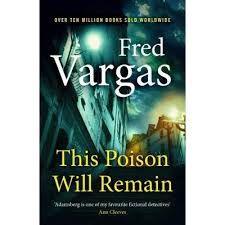Fred Vargas, This Poison Will Remain (2017).
GoodReads meta-data is 416 pages, rated 4.04 by 2318 litizens.
Genre: krimi
Verdict: [Sigh]
The fog that is Chief Inspector Jean-Basptiste Adamsberg returns. This time in pursuit of shy spiders. José Garcia brought Adamsberg to life in a film years ago, and I still picture Garcia when I read these titles.
A number of elderly men die from the bite of the so-called reclusive spider. Oh hum. Yet Adamsberg cannot stop thinking about it. An arachnidologist he consults assures him the bite of this spider is not fatal, yet there are the three deaths associated with bites from just such spiders. Others are content to conclude that their age led to death triggered by the spider bite. Now if Adamsberg had reacted against this ageism we might have had an interesting story, because throughout the ages of the victims is used to dampen, dismiss, or deter interest in the case(s), but no Adamsberg just has one of his ineffable hunches. Tant pis.
Of course, if his boss had been versed in McKinsey management KPIs Adamsberg would never have been permitted to pursue this obvious dead-end. ‘Stick to the cases that can be cleared to make us look good,’ that would have been the direction.
There is much to’ing and fro’ing here and there, and — as usual —there are ructions in the squad. Situation normal. There are the Cartesian positivists who follow Adrien Danglard, the nominal number two in the unit versus the metaphysicians who follow Adamsberg. The computer nerd Froissy is there, along with the Amazon Violette Retancourt, sleepy Mordent, Mercadet, Voisenet, Noël with the short fuse, and Veyrenc with the strange head of hair, Estalère who worships Adamsberg, Justin who does not, Kernorkian, and Lamarre. Let’s not forget Snowball on top of the photocopier.

While I have enjoyed previous titles in this series I cannot be enthusiastic about this entry, which seems padded with pointless and repetitive dialogue and more repetitive and pointless dialogue while very little happens. The evocation of place which was a highlight in earlier entries is absent here. Nîmes is just a five-letter word here, not a place. Nor are there any surprising characters like the stableman or the sailor who figured in earlier novels. Still less do the victims have any character. Again unlike some earlier entries when the character of the victim was crucial.
That the villain could fire that weapon with such deadly accuracy in all the circumstances is an assumption too far for even this indulgent reader.

